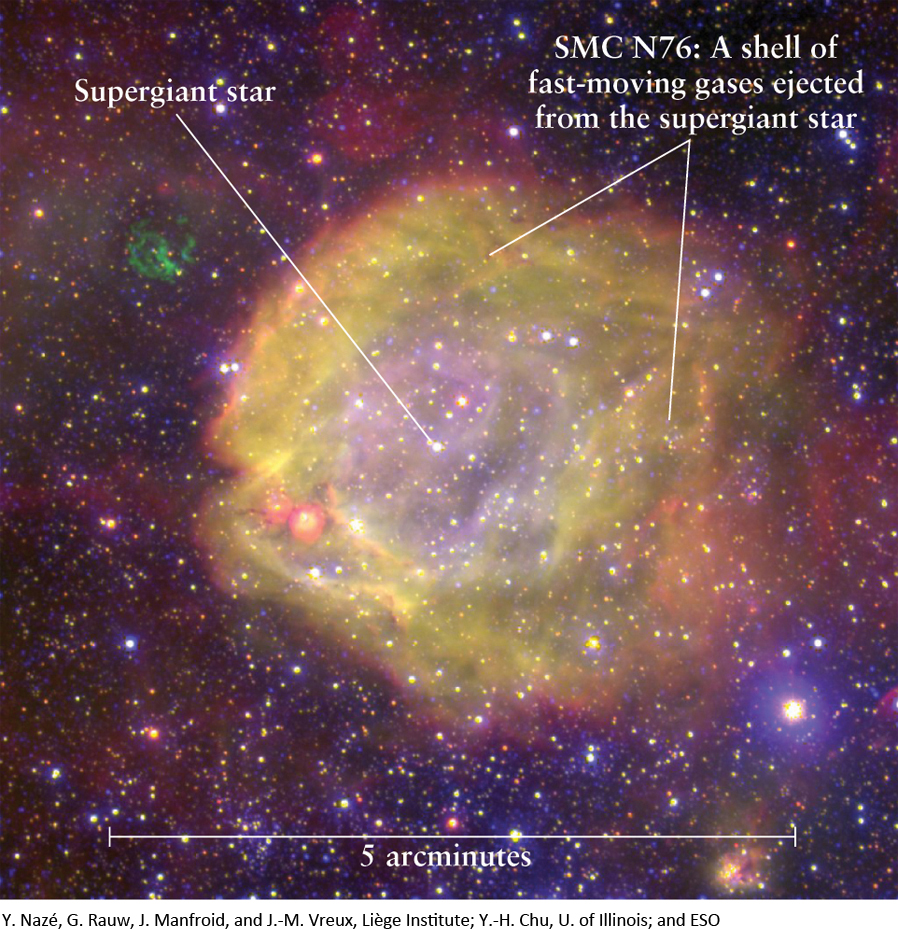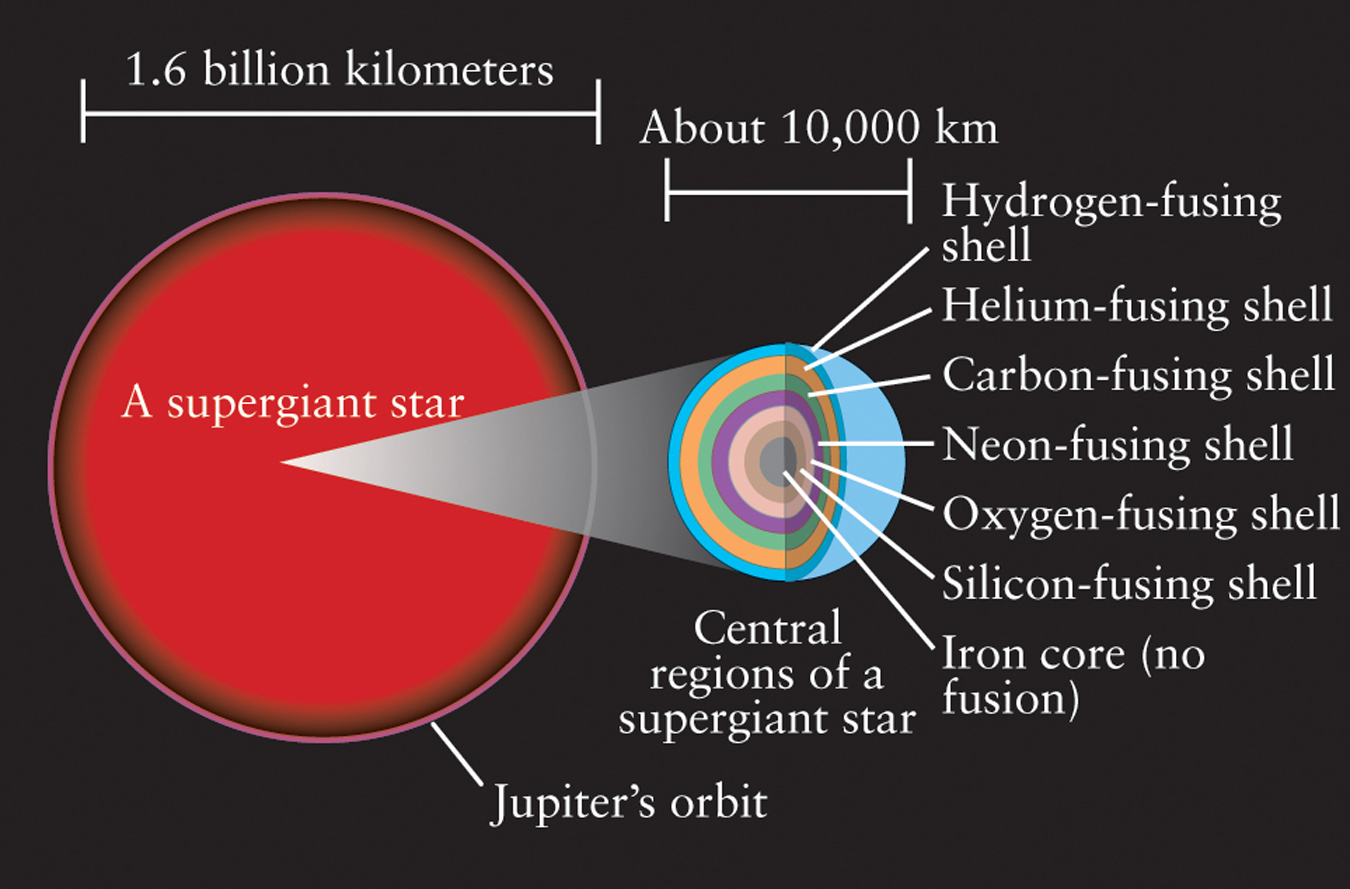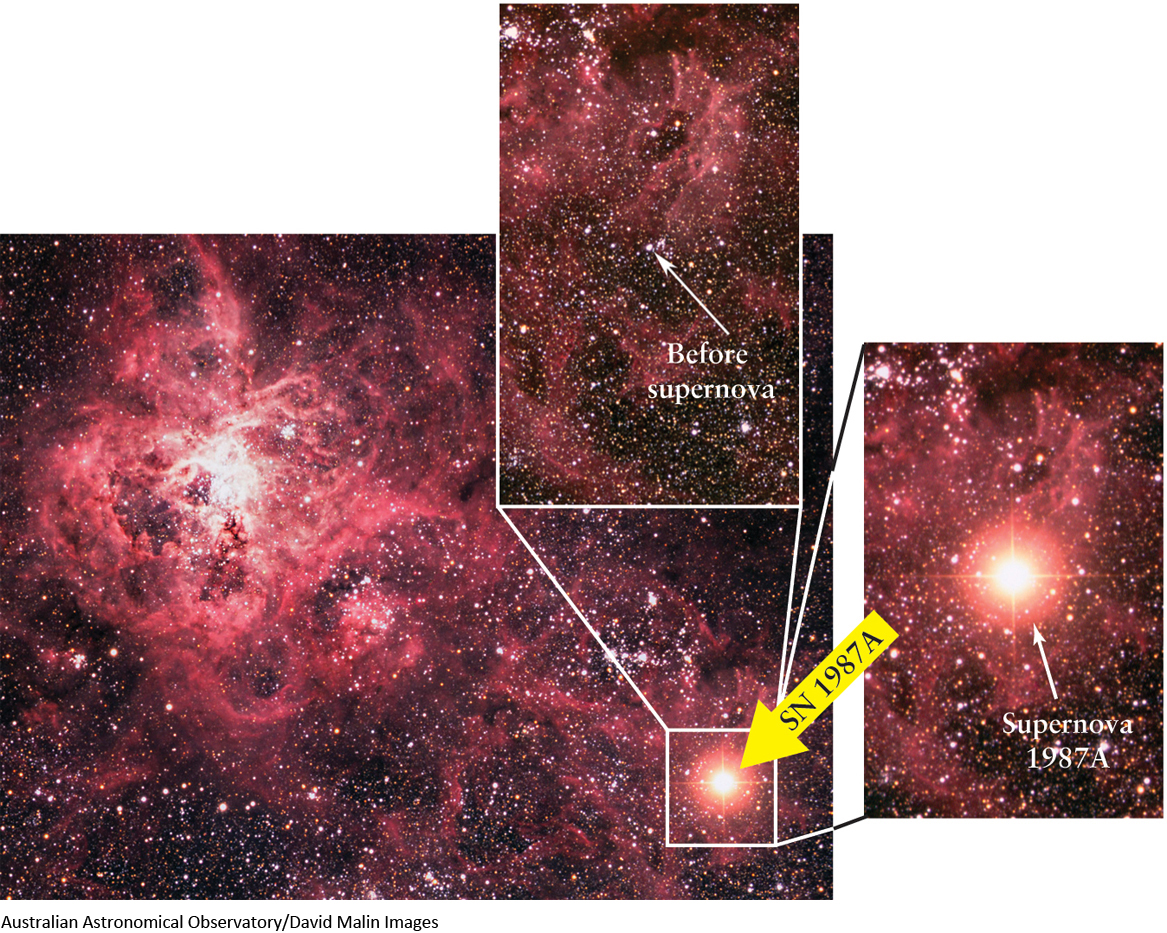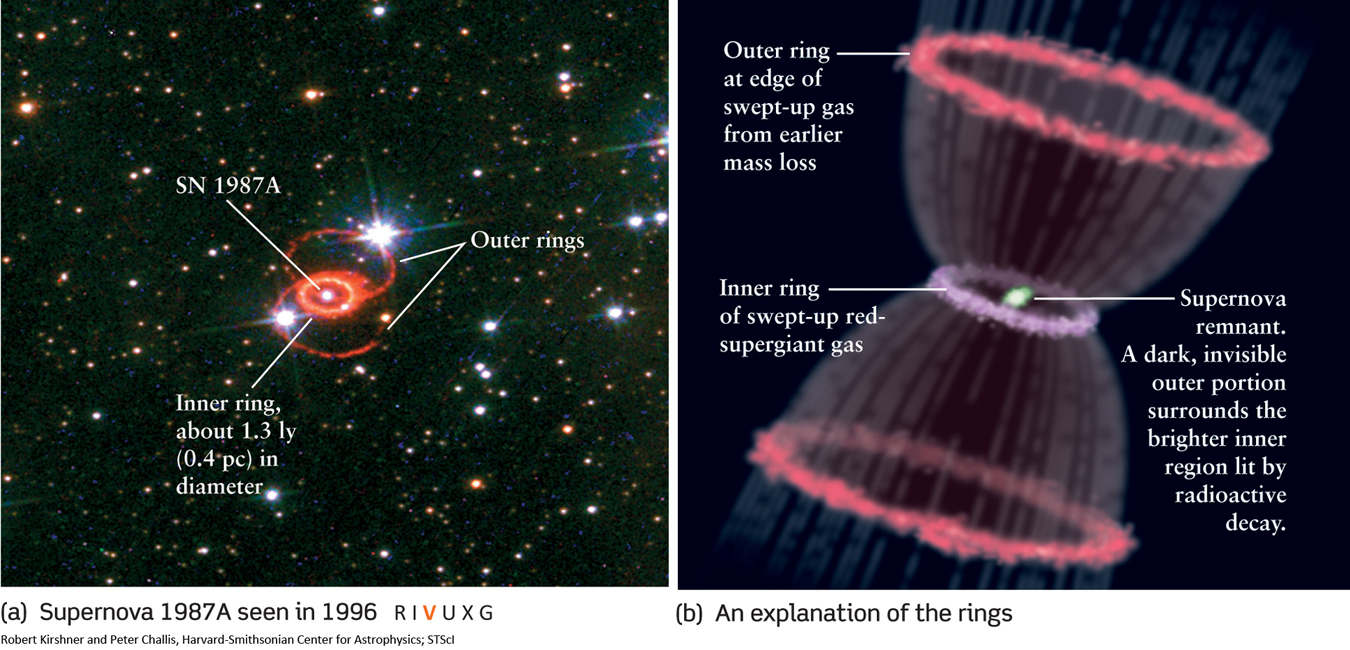12-1 High-mass stars create heavy elements in their cores before violently blowing apart in supernova explosions, leaving behind remnants
The elements larger than hydrogen and helium up to iron are primarily made within stars.
The swollen red giant and white dwarf end-state of a star like our Sun is stunning indeed. But what about stars many more times massive than the Sun? The life story of a high-mass star (with an initial mass greater than about 4 M⊙) begins with the same hydrogen-fusing-into-helium reactions that we observe in smaller stars. But theoretical calculations show that high-mass stars can also go through several additional stages of thermonuclear reactions, involving the fusion of carbon, oxygen, and other heavy nuclei. As it turns out, the failure of internal pressure from thermonuclear reactions to hold up the crushing weight of a giant star’s outer layers is much more catastrophic.
Heavy-Element Fusion in Massive Stars
One of the key differences between Sunlike stars and those that are many times more massive is that the largest stars are able to forge the heaviest of chemical elements. Why is fusion of heavy nuclei possible only in a high-mass star? The reason is that heavy nuclei have large electric charges. For example, the nucleus of a carbon atom has 6 positively charged protons and hence 6 times more positive electrical charge than a hydrogen nucleus (which has a single proton). This means that there are strong electric forces that tend to keep these positively charged nuclei apart. Only at the great speeds associated with extremely high temperatures can the nuclei travel fast enough to overcome their mutual electric charge repulsion and fuse together. To produce these very high temperatures at a star’s center, the pressure must also be very high. Hence, only the largest stars have enough mass bearing down on the core to produce extremely high temperatures at the center.
As we discussed in Chapter 11, when a main-sequence star with a mass greater than about 0.4 M⊙ uses up its available core hydrogen, it begins shell hydrogen fusion and enters a red-giant phase. But in stars whose overall mass is more than about 4 M⊙, the carbon-oxygen core is more massive than the Chandrasekhar limit of 1.4 M⊙, so degenerate-electron pressure from tightly packed atoms cannot itself prevent the core from contracting and heating. As a result, a high-mass star is able to enter a new phase of core thermonuclear reactions. When the central temperature of such a high-mass star reaches 600 million kelvins (6 × 108 K), the first of the new thermonuclear reactions begins with carbon. The thermonuclear process of carbon fusion consumes carbon nuclei (12C, with 6 protons in each nucleus) and produces oxygen (16O, 8 protons), neon (20Ne, 10 protons), sodium (23Na, 11 protons), and magnesium (23Mg and 24Mg, each with 12 protons).
If a star has an even larger main-sequence mass of about 8 M⊙ or so (before mass ejection), even more thermonuclear reactions can take place. After the cessation of carbon fusion, the core will again contract, and the star’s central temperature can rise to 1 billion kelvins (109 K). At this temperature, fusion of neon nuclei can begin. This uses up the neon accumulated from carbon fusion and further increases the concentrations of oxygen and magnesium in the star’s core.
After neon fusion ends, the core will again contract, and oxygen nuclei will begin to fuse into silicon (28Si, 14 protons) when the central temperature of the star reaches about 1.5 billion kelvins (1.5 × 109 K). Once oxygen fusion is over, the core will contract yet again. If the central temperature reaches about 2.7 billion kelvins (2.7 × 109 K), silicon will begin to fuse, producing a variety of nuclei from sulfur (32S, 16 protons) to iron (56Fe, 26 protons) and nickel (56Ni, 28 protons). While all of this is going on in the star’s interior, at the surface the star is losing mass at a rapid rate (Figure 12-1).

281
As a high-mass star consumes increasingly heavier nuclei, the thermonuclear reactions produce a wider variety of products. For example, oxygen fusion produces not only silicon, but also magnesium (24Mg, with 12 protons), phosphorus (31P, with 15 protons), and sulfur (31S and 32S, each with 16 protons). Some thermonuclear reactions that create heavy elements also release neutrons. A neutron is like a proton except that it carries no electric charge. Therefore, neutrons are not repelled by positively charged nuclei, and so can easily collide and combine with them. This absorption of neutrons by nuclei creates many elements and isotopes that are not produced directly in fusion reactions.
Question
ConceptCheck 12-1: If the core of our Sun was compressed to a much higher density and able to maintain a temperature of 1.5 billion kelvins (1.5 × 109 K) in its core, what would happen to the helium in its very center?
Supergiant Stars and Their Evolution
The increasing density and temperature of the core make each successive thermonuclear reaction more rapid than the one that preceded it. As an example, Table 12-1 shows a theoretical calculation of the evolutionary stages for a star with a birth mass of 25 M⊙. This calculation indicates that carbon fusion in such a star lasts for 600 years, neon fusion for 1 year, and oxygen fusion for only 6 months. The last, and briefest, stage of nuclear reactions is silicon fusion. The entire core supply of silicon in a 25-M⊙ star is used up in only one day!
| Stage | Core temperature | Core density (kg/m3) | Duration of stage |
|---|---|---|---|
| Hydrogen fusion | 4 × 107 | 5 × 103 | 7 × 106 years |
| Helium fusion | 2 × 108 | 7 × 105 | 7 × 105 years |
| Carbon fusion | 6 × 108 | 2 × 108 | 600 years |
| Neon fusion | 1.2 × 109 | 4 × 109 | 1 year |
| Oxygen fusion | 1.5 × 109 | 1010 | 6 months |
| Silicon fusion | 2.7 × 109 | 3 × 1010 | 1 day |
| Core collapse | 5.4 × 109 | 3 × 1012 | ¼ second |
| Core bounce | 2.3 × 1010 | 4 × 1017 | milliseconds |
| Explosive supernova | about 109 | varies | 10 seconds |
Each stage of core fusion in a high-mass star generates a new shell of material around the core. After several such stages, the internal structure of a truly massive star—say, 25 to 30 M⊙ or greater—resembles that of an onion (Figure 12-2). Because thermonuclear reactions can take place simultaneously in several shells, energy is released at such a rapid rate that the star’s outer layers expand tremendously. The result is a supergiant star, whose luminosity and radius are much larger than those of a giant. Several of the brightest stars in the sky are supergiants, including Betelgeuse in the constellation Orion and Antares in the constellation Scorpius. (Figure 10-15 shows the locations of these stars on an H-R diagram.)

282
A supergiant star cannot keep adding shells to its “onion” structure forever, because the sequence of thermonuclear reactions cannot go on indefinitely. In order for an element to serve as a thermonuclear fuel, energy must be given off when its nuclei collide and fuse. This released energy is a result of the strong nuclear force of attraction that draws nucleons (neutrons and protons) together. However, protons also repel one another by the weaker electric force. As a result of this electric repulsion, adding extra protons to nuclei larger than iron, which has 26 protons, requires an input of energy rather than causing energy to be released. Nuclei of this size or larger cannot act as fuel for thermonuclear reactions. Hence, the sequence of fusion stages ends with silicon fusion. One of the products of silicon fusion is iron, and the result is a star with an iron-rich core in which no thermonuclear reactions take place (see Figure 12-2).
Shell fusion in the layers surrounding the iron-rich core consumes the star’s remaining reserves of fuel. At this stage the entire energy-producing region of the star is contained in a volume no bigger than Earth, some 106 times smaller in radius than the overall size of the star. This state of affairs will soon come to an end, because the buildup of an inert, iron-rich core signals the impending violent death of a massive supergiant star.
Question
ConceptCheck 12-2: How long does the neon fusion stage last in a Sunlike star?
The Violent End of a High-Mass Star
To understand what happens in a core-collapse supernova explosion, we must look deep inside a massive star at the end of its life. Of course, we cannot do this in actuality, because the interiors of stars are opaque. But astronomers have developed theoretical models based on what we know about the behavior of gases and atomic nuclei. The story that follows, while largely theoretical, describes our observations of supernovae fairly well.
When energy production at the core of a massive star ends, a catastrophic collapse leads to a supernova explosion.
The core of an aging, massive star gets progressively hotter as it contracts to ignite successive stages of thermonuclear fusion (Stage 1 in Figure 12-3). Remember that as the temperature of an object like a star increases, so does the energy of the photons it emits. When the temperature in the core of a massive star reaches a few hundred million kelvins, the photons are energetic enough to initiate a host of nuclear reactions that create neutrinos that escape, draining the star’s energy.

To compensate for the energy drained by the neutrinos, the star must provide energy either by consuming more thermonuclear fuel, by contracting, or both. But when the star’s core is converted into iron, no more energy-producing thermonuclear reactions are possible, and the only source of energy is contraction and rapid heating (Stage 2 in Figure 12-3).
Once a star with an original mass of about 8 M⊙ or more develops an iron-rich core, the core contracts very rapidly, so that the core temperature skyrockets to 5 × 109 K within a tenth of a second. The gamma-ray photons emitted by the intensely hot core have so much energy that when they collide with iron nuclei, they begin to break the iron nuclei down into much smaller helium nuclei (4He). As Table 12-1 shows, it takes a high-mass star millions of years and several stages of thermonuclear reactions to build up an iron core; within a fraction of a second, the degradation process undoes the result of those millions of years of reactions.
Within another tenth of a second, the core becomes so dense that the negatively charged electrons within it are forced to combine with the positively charged protons to produce electrically neutral neutrons. This process also releases a flood of neutrinos, denoted by the Greek letter ν (nu):
e− + p →; n + ν
At about 0.25 second after its rapid contraction begins, the core is less than 12 miles (20 km) in diameter and its enormous density is in excess of 4 × 1017 kg/m3. This is tremendously dense and is the density with which neutrons and protons are packed together inside the nucleus of an atom. (If Earth were compressed to this density, it would be only 300 meters, or 1000 feet, in diameter.)
Matter at the density where neutrons and protons are packed together is extraordinarily difficult to compress to an even more dense state. Thus, when the density of the neutron-rich core begins to exceed this state, the core suddenly becomes very stiff and rigid. The core’s contraction comes to a sudden halt, and the innermost part of the core actually bounces back and expands somewhat. This core bounce sends a powerful wave of pressure, like an unimaginably intense sound wave, outward into the outer core (Stage 3 in Figure 12-3).
During this critical stage, the cooling of the core has caused the pressure to decrease profoundly in the regions surrounding the core. Without pressure to hold it up against gravity, the material from these regions plunges inward with great speed and force. When this inward-moving material crashes down onto the rigid core, it encounters the outward-moving pressure wave. In just a fraction of a second, the material that fell onto the core begins to move back out toward the star’s surface, propelled in part by the flood of neutrinos trying to escape from the star’s core.
In this process, the material surrounding the core behaves somewhat like water boiling furiously in a heated pot. Rising bubbles of superheated gases deliver extra energy to the pressure wave, sustaining it and making it accelerate as it plows outward through the doomed star’s outer layers. The wave soon reaches a speed greater than the speed of sound waves in the star’s outer layers. When this happens, the wave becomes a shock wave, like the sonic boom produced by a supersonic airplane (Stage 4 in Figure 12-3).
283
A few hours after the event actually happens, the shock wave eventually reaches the star’s surface, by which time the star’s outer layers have begun to lift away from the core. When the star’s outer layers thin out sufficiently, a portion of this energy escapes in a torrent of light (Stage 5 in Figure 12-3). The star has become a core-collapse supernova (plural supernovae).
CAUTION
The energy released in a core-collapse supernova is incomprehensibly large—100 times more energy than the Sun has emitted due to thermonuclear reactions over its entire 4.57-billion-year history. However, it is important to recognize that the source of the supernova’s energy release is not thermonuclear reactions. Rather, it is the gravitational energy released by the collapse of the core and by the inward fall of the star’s outer layers. (You release gravitational energy when you fall off a diving board, and this released energy goes into making a big splash in the swimming pool.) The energy released by the collapse of the core reappears in the form of neutrinos; the fall of the outer layers provides the energy to power the nuclear reactions that generate the supernova’s electromagnetic radiation. The amount of energy release from the supernova is so great because the star is so massive. Hence, the amount of material that falls inward is immense, it falls a great distance, and it is acted on by a strong gravitational pull as it falls.
Question
ConceptCheck 12-3: Is the supernova resulting from the death of a supermassive star an outwardly directed explosion or an inwardly directed implosion?
284
Supernova 1987A: A Close-up Look at the Death of a Massive Star
 Go to Video 12-1
Go to Video 12-1
Supernovae can have a maximum luminosity as great as 109 L⊙, rivaling the light output of an entire galaxy for a brief period. This makes it possible to see supernovae in galaxies far beyond our own Milky Way Galaxy, and indeed hundreds of these distant supernovae are observed each year (Figure 12-4).

On February 23, 1987, a supernova was discovered in the nearby Large Magellanic Cloud (LMC), a companion galaxy to our Milky Way some 168,000 ly from Earth. The supernova, designated SN 1987A because it was the first discovered that year, occurred near a region in the LMC called the Tarantula Nebula (Figure 12-5). The supernova was so bright that observers in the southern hemisphere could see it without a telescope. Perhaps surprisingly, the light from a supernova such as SN 1987A does not all come in a single brief flash; the outer layers continue to glow as they expand into space. For the first 20 days after the detonation of SN 1987A, its glow was powered primarily by the tremendous heat that the shock wave deposited in the star’s outer layers. As the expanding gases cooled, the light energy began to be provided by a different source—the decay of radioactive isotopes of cobalt, nickel, and titanium produced in the supernova explosion.

285
Astronomers have been able to pinpoint the specific isotopes involved because different radioactive nuclei emit gamma rays of different wavelengths when they decay. Thanks to the energy released during these radioactive decays, the brightness of SN 1987A actually increased for the first 85 days after the detonation, then settled into a slow decline as the radioactive isotopes were used up. The supernova remained visible to the naked eye for several months after the detonation.
Three and a half years after we observed SN 1987A explode, astronomers used the newly launched Hubble Space Telescope to obtain a picture of the supernova. To their surprise, the image showed a set of three glowing rings (Figure 12-6a). These rings are relics of a hydrogen-rich outer atmosphere that was ejected by gentle stellar winds from the star when it was a red supergiant, about 20,000 years ago. This diffuse gas expanded in a hourglass shape (Figure 12-6b), because it was blocked from expanding around the star’s equator either by a preexisting ring of gas or by the orbit of an as yet unseen companion star. The outer rings in Figure 12-6a are parts of the hourglass that were ionized by the initial flash of ultraviolet radiation from the supernova.

By the early years of the twenty-first century, the shock wave from the supernova was beginning to be seen to collide with the “waist” of the hourglass shown in Figure 12-6b. This collision is making the hourglass glow more brightly in visible wavelengths—though not enough, unfortunately, to make the supernova again visible to the naked eye—and emit copious radiation at X-ray and ultraviolet wavelengths.
Question
ConceptCheck 12-4: How might the appearance of SN 1987A be different if the star had not been encircled by a ring of dust about its equator?